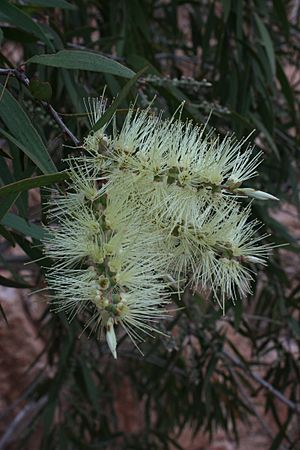Melaleuca fluviatilis facts for kids
Quick facts for kids Melaleuca fluviatilis |
|
|---|---|
 |
|
| Scientific classification | |
| Genus: |
Melaleuca
|
| Species: |
fluviatilis
|
Melaleuca fluviatilis is a special kind of tree that belongs to the myrtle family, called Myrtaceae. You can only find it growing naturally in northern Queensland, Australia. This tree has interesting papery bark and long, narrow leaves. When it blooms, it shows off spikes of white or creamy-colored flowers. You'll usually spot these trees growing near streams and rivers, which is why its name, fluviatilis, means "of rivers" in Latin! It's quite common in warm, tropical places. Sometimes, people might confuse it with another tree, Melaleuca argentea, but Melaleuca fluviatilis doesn't have the shiny, silver leaves that Melaleuca argentea does.
Contents
What Does This Tree Look Like?
Melaleuca fluviatilis is a tree that can grow very tall, sometimes up to 30 m (100 ft) (about 100 feet)! It has white or greyish bark that peels off in thin, papery layers. Its branches often hang down, giving it a "weeping" look.
Its Leaves
The leaves grow one after another along the branches. They are quite long and narrow, usually about 45–180 mm (2–7 in) (1.8 to 7 inches) long and 5–19 mm (0.2–0.7 in) (0.2 to 0.7 inches) wide. They have a shape like a narrow oval, and you can see 5 to 7 lines running parallel (side-by-side) along them. When the leaves are young, they feel soft because they are covered in tiny, fine hairs. But as they get older, these hairs disappear, and the leaves become smooth.
Its Flowers
The flowers of Melaleuca fluviatilis are white to creamy green. They grow in long, bottle-brush-like spikes near the ends of the branches, where the leaves meet the stem. Each spike can have 3 to 18 small groups of flowers, with three flowers in each group. These spikes can be up to 100 mm (3.9 in) (about 4 inches) long and 40 mm (1.6 in) (about 1.6 inches) wide.
The petals on each flower are small, only about 1.5–3.5 mm (0.06–0.1 in) long. They fall off soon after the flower opens. Inside the flower, there are many thin, thread-like parts called stamens. These stamens are grouped into five bundles around the center of the flower, with 3 to 9 stamens in each bundle.
When It Blooms and Fruits
You can see these beautiful flowers from May to October. After the flowers fade, they are replaced by small, woody fruits. These fruits are like little capsules, about 2.5–4 mm (0.1–0.2 in) long, and they hold the tree's seeds.
How It Got Its Name
The scientific name Melaleuca fluviatilis was first officially described in 1997 by a scientist named Bryan Barlow. He found a sample of the tree in a sandy river bed north of Townsville, Australia.
The second part of its name, fluviatilis, is a Latin word. It means "pertaining to rivers" or "found in rivers." This name perfectly describes where this tree loves to grow!
Where Does This Tree Grow?
This type of melaleuca tree is found all over the Cape York Peninsula in northern Queensland. It also grows further south, reaching places like Gladstone and Biloela. You can even find it as far west as Croydon, Boodjamulla National Park, and Forest Den National Park.
Melaleuca fluviatilis can grow in different types of soil. However, it usually prefers to grow along rivers and streams. You might also see it on the edges of swampy open forests. It often grows alongside plants found in rainforests or in dry sclerophyll forests, which are forests with tough, hard-leaved plants.

